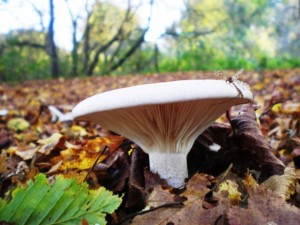I came across this fine specimen of Clitocybe, part of a larger larger group, in the Wilderness one weekend before Christmas, and this species was very abundant on campus in 2011. Globally, there are hundreds of species of Clitocybe which are generally recognised by their funnel-shaped cap (Clitocybe meaning ‘sloping head’). Clitocybe’s are pale white to brown or lilac in colour with spores white, off-white, buff, cream, pink, or light-yellow depending on species and with gills running down the stipe (i.e. decurrent). A few members of the genus are edible but many others are highly poisonous containing the toxin muscarine amongst others. Clitocybe is a difficult group to identify and recent molecular work has thrown the group into the air taxonomically, with many species previously considered Clitocybes now considered only distantly related and other quite different fungi, such as the field blewit and wood blewit, now grouped in with Clitocybe. With fungi nothing is quite as it seems; for example traditionally considered a type of plant, in reality fungi have more in common with animals than they do with plants! So look out for these weird and wonderful beasts on campus this autumn and let us know what you find. If you’re just starting on fungi identification Roger Phillips popular book is now all online at http://www.rogersmushrooms.com there are some simple keys and loads of pictures to get you going.
-
Recent Posts
Recent Comments
- On la remarque sur cet anisodontea … – Jaccueillelanature on The Hornet Hoverfly- Volucella zonaria
- Campus Wildlife Champions – T&L Exchange on Campus Species Lists
- Powdery Mildew Survey 2016 | Culham Research Group on Powdery mildew – 2014
- Powdery Mildew Survey 2016 | Culham Research Group on Powdery mildew – 2015
- Alastair Culham on Mammals
Archives
Categories
Kite Site
My TweetsMeta


A great blog! I’ve been watching the Clitocybes in the Wilderness for several months now. The last few that emerged in the Autumn are still present in sheltered spots. The toadstools are now pale brown having gradually darkened over the past few months. Several have other fungi attacking them and all the ones near paths seem to have been destroyed.